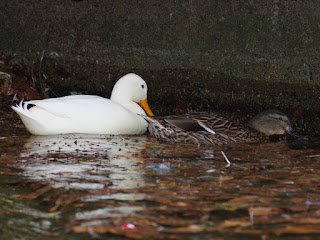The Black Swan was beside the platform of Bluebird Boats with girlfriend number two.
Meanwhile, girlfriend number one has been seen displaying with a white admirer, so it looks as if she's definitely out of the trio.
On the other side of the platform, the two Canada-Greylag hybrid siblings were together.
There were four in this brood. One, we are fairly sure, died here while the others were away. But only two have returned.
There was one female Gadwall on the Serpentine ...
... with three drakes, one of which is shown here.
Although Gadwalls tend to go around in pairs, there is still the same skewed sex ratio that you see in other species of duck.
The white Mallard was with his brown mate in the shadows under the platform of the Dell restaurant.
Even here he shines brilliantly white. The Mute Swans look grubby in comparison.
The new Great Crested Grebe nest on the island is a soggy affair even by grebe standards, and the surface is awash when one of the birds stands on it. More work is needed here.
The Wren that lives in the flower planters at the Dell restaurant posed beside a polyanthus.
And a Wood Pigeon had placed itself decoratively among the snowdrops on the west side of the Long Water near the Italian Garden.
There is a clump of birch trees here, and for the second time I saw two Treecreepers running up the trunks.
Possibly they are nesting here. You usually think of Treecreepers as favouring trees with rough, deeply fissured bark, but evidently the flaking birch bark is also a good place to find insects. The birds may even be making a nest behind a big flake.
In a comment on yesterday's post, Cathy mentioned an interesting article on household birds in the Middle Ages, including this illustration of a green parrot which is probably meant to be one of our familiar Rose-Ringed Parakeets.
The book is the British Library Harley MS 3244, written between 1236 and 1265.










No comments:
Post a Comment